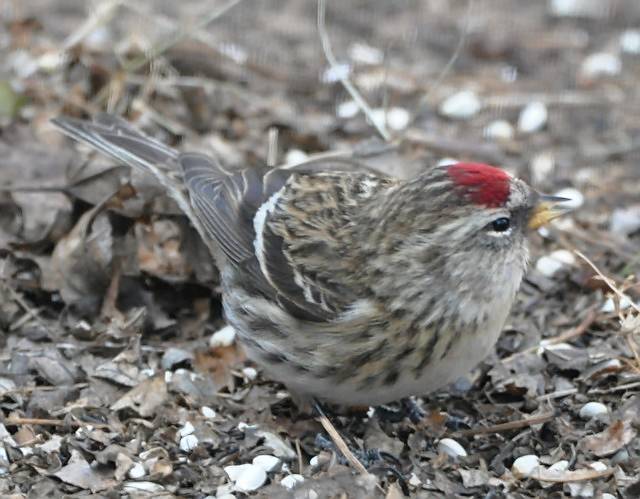By John Shackford

This winter, with its arctic air masses coming frequently and deeply into the United States, has brought us several far north bird species we rarely find in the state; one of these is the Common Redpoll (Acanthis flammea). Acanthis is Latin for small song-bird, and flammea is Latin for flame. The common name—redpoll—is derives from pol, Middle English for head; thus redpoll means red head. At 5 inches in length this species is a small streaked finch with a red forehead. Adult males have a black chin with a wash of red on the chest. There is another species quite similar to the Common Redpoll, the Hoary Redpoll; this species has “lighter, frostier-looking” plumage that shows considerably less strong streaking on the rump, flanks and under tail coverts. So if you see a redpoll you need to be sure it is not a Hoary Redpoll.
On 14 January 2018 members Steve Davis and Mary Lane had a Common Redpoll, apparently a female, show up in their yard. Early that afternoon Steve and Mary were looking at some American Goldfinches and Dark-eyed Juncos feeding on the ground in their backyard. They were trying to photograph an unusual junco, one with extra white in its tail; Steve had the camera and Mary had binoculars. Steve saw an unusual bird and asked Mary what it was. Upon looking, she thought it was going to be a House Finch, but almost immediately realized it was a Common Redpoll; very quickly Steve posted photos on eBird, OKBirds, and the OOS Facebook page. Soon the redpoll jumped up into a tree, then flew away; their total viewing time was about 10 minutes. This is the only time they have seen the bird, but they are still looking!
The Common Redpoll was not placed on the official list of species for the state until 1976, when Elizabeth Hayes and others got good photos of a bird in Tulsa (Hayes, 1978. Bull. Oklahoma Orn. Soc., 9: 30-32). G. M. Sutton [1982. Species summaries of Oklahoma bird records] listed 10 redpolls or groups of redpolls (many among the 10 were seen at the same location on multiple day and were therefore believed to be “repeats”). eBird, which started in 2002, lists 5 occurrences up to the present (including Steve and Mary’s). I do not know if there were any sightings in the 20 years between Sutton’s death in 1982 and the beginning of eBird in 2002 (it is possible to post records earlier than 2002 on eBird, but I suspect little activity in this regard). Thus there are about 15 records over the 95 years between when the Common Redpoll was first reported in the state (1922) and the present, one record about every 6.3 years.
In 1978 Wesley Isaacs, a former member of our club, had an adult male regularly at a feeder in his yard, from 13 January to 23 February. I heard about it and went to Wes’ house to help him catch the bird. I was supposed to arrive at Wes’s at 0800. Wes put up his banding net at 0800, then walked around the house to greet me at 0803; we walked back around to the backyard and the bird was in the net! This bird was an adult male with a rosy wash on the breast, the only Oklahoma record I can find of an adult male.
As a nesting bird in the Arctic, the Common Redpoll lays 3-7 eggs, but usually 4-5 in coniferous or birch trees, many of them dwarf. I was surprised to read that their nests can be quite difficult to find, because adult birds would readily slip away from the nest as an intruder approached. You would think that birds in the far north—”beyond civilization”—would be quite tame, but the birds apparently have other considerations, possibly non-human predators, to worry about.
In writing this column I came across an article about rare winter visitors from the far north, including both the redpoll and Snowy Owl. The discussion came around to an interesting point: It is well-documented that people and at least some animals will work harder to get an intermittent reward than to get a reward that always comes or never comes. You will recognize this as the psychology behind gambling; but instead of gambling for money, we birdwatchers are gambling for the payoff of seeing a rare bird! And I suspect it is probably just as well that most of us “addicted birding personalities” do not spend much time in casinos!
